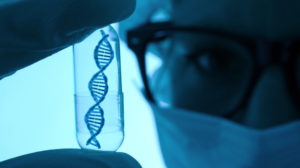Scientists are getting closer to blocking the ALS gene. Read on to learn all about it.
RELATED: Pregnancy May Switch Off Cancer Genes In Mother
In this Article:
- Amyotrophic Lateral Sclerosis (ALS)
- Discovering the ALS Gene: SOD1
- Turning off the ALS Gene
- Groundbreaking Methods
- Gene Suppression Therapy
- The Future
Turning off the ALS Gene and the Future of Gene Suppression Therapy
Amyotrophic Lateral Sclerosis (ALS)

Amyotrophic lateral sclerosis (ALS) or Lou Gerig’s disease is a progressive disease that involves the nerves in the brain and spinal cord. As the disease progresses, it attacks the neurons that regulate voluntary movement.
It often begins with the loss of voluntary muscle movement and then speech. As it advances, it affects an individual’s ability to swallow and breathe.
According to the Centers for Disease Control and Prevention (CDC), individuals who have this disease have shorter lifespans. In fact, people with ALS usually die within five years after the initial diagnosis.
The CDC also reports that this disease is more common in white men over 60 years old. ALS is fatal, and until recently, there was very little hope for a cure.
Discovering the ALS Gene: SOD1
In 1993 a group of researchers from the University of Massachusetts Medical School, Massachusetts General Hospital, and Johns Hopkins published a paper where they discovered the ALS gene SOD1. The SOD1 gene is responsible for 2% of ALS cases.
Identifying and targeting this gene is useful for treating hereditary ALS. They found that they could turn off the gene in the laboratory.
After over two decades of work, some of the original researchers found a way to test their laboratory findings in a human setting. They recently published their results in The New England Journal of Medicine.
RELATED: Cancer Epigenetic Driver Mutations in ARID1A
Turning off the ALS Gene
In their study, the researchers discover a potential way to fight against ALS. Hereditary ALS is usually triggered by genes that malfunction, like SOD1.
Using a virus, the researchers delivered micro-RNAs to block or turn off the SOD1 gene. They administer the virus through the spinal fluid.
After administering the virus, there was a decrease in that gene’s activity in the spinal cord. They also found preliminary evidence of clinical benefits like improved strength among the patients, but this needs to be further verified.
Groundbreaking Methods
According to Professor Robert Brown, one of the researchers and the Director of the University of Massachusetts’ Medical School Program, the study uses groundbreaking methods. It’s the first time scientists used a virus to deliver the micro-RNA as a form of epigenetic intervention for any disease.
The key was to find a virus that was safe enough for human administration. The researchers didn’t have to go far to find ideas.
The Dean of the Massachusetts Medical School was the first scientist to use the same virus on human subjects. So the SOD1 researchers collaborated with him to design their experiment.
These preliminary findings are small steps towards utilizing biologic reagents as a form of treatment. The researchers hope that this is just the first step towards new treatment options for late-onset neurodegenerative diseases—especially those that individuals inherit from their families.
Gene Suppression Therapy

Many adult-onset neurodegenerative diseases, such as Alzheimer’s and Parkinson’s disease, are hereditary. They are often triggered by genes that behave in ways they’re not supposed to.
For instance, genes can start making harmful proteins or RNA. The results of the study show that there’s a lot of potential in gene suppression therapies.
It’s important to note that there’s a difference between gene therapy and gene suppression therapy. Gene therapy usually involves replacing missing genes, while gene suppression therapies target harmful gene expressions.
The Future
These findings may be promising, but it will take years to use these therapies on ASL patients. Researchers are currently running more studies to confirm these results with larger sample sizes. On top of that, other pharmaceutical companies and academic laboratories continue to explore the possible applications of epigenetic treatments like gene suppression therapies.
In the meantime, you can take advantage of what scientists already know about epigenetics and its health applications. If you want to learn more about epigenetics and what it can do for you, visit the TruDiagnositc website.
What excites you the most about these new findings? Share your thoughts with us in the comment section below.
Sources:
Up Next:





